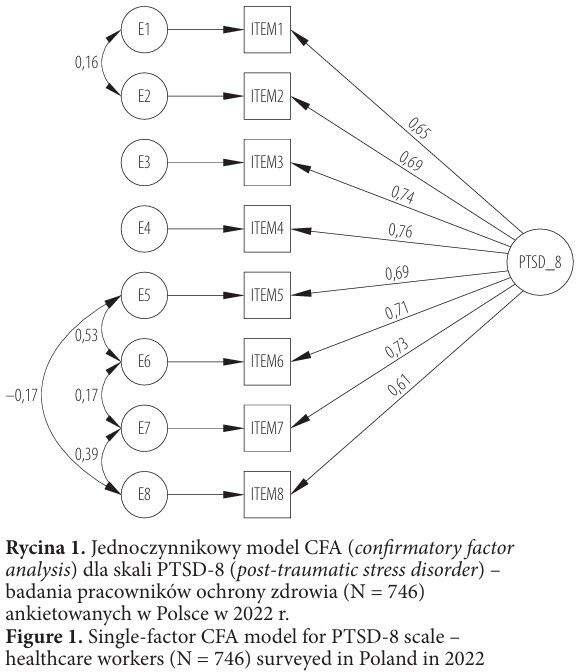Online first
Current issue
Archive
Most cited in 2024
About the Journal
Editorial Office
Editorial Board
Copyright and self-archiving policy
Information clause on the processing of personal data
Declaration of accessibility
Instructions for Authors
Instructions for Reviewers
Contact
Reviewers
2024
2023
2022
2020
2021
2019
2018
2017
2016
2015
2014
2013
Editing and translations
ORIGINAL PAPER
Polish version of the questionnaire for measuring post-traumatic stress disorders PTSD-8 in studies of four groups of medical professions
1
Uniwersytet Zielonogórski / University of Zielona Gora, Zielona Góra, Poland (Katedra Humanizacji Medycyny i Seksuologii, Collegium Medicum / Department of Humanization of Medicine and Sexology,
Collegium Medicum)
2
Uniwersytet Warszawski / Warsaw University, Warsaw, Poland (Ośrodek Badań nad Migracjami / Centre of Migration Research)
3
Uniwersytet Warszawski / Warsaw University, Warsaw, Poland (Katedra Biomedycznych Podstaw Rozwoju i Seksuologii, Wydział Pedagogiczny / Department of Biomedical Developmental Basis
and Sexology, Faculty of Pedagogy)
Online publication date: 2024-02-20
Corresponding author
Joanna Mazur
Uniwersytet Zielonogórski, Katedra Humanizacji Medycyny i Seksuologii, Collegium Medicum, ul. Energetyków 2, 65-046 Zielona Góra
Uniwersytet Zielonogórski, Katedra Humanizacji Medycyny i Seksuologii, Collegium Medicum, ul. Energetyków 2, 65-046 Zielona Góra
Med Pr Work Health Saf. 2024;75(1):45-56
KEYWORDS
healthcare workersPolish adaptationpost-traumatic stress disorderpost-traumatic factor analysisCOVID-19PTSD‑8 questionnaire
TOPICS
ABSTRACT
Background: There are several techniques to diagnose post-traumatic stress disorder (PTSD) symptoms that correspond to the Diagnostic
and Statistical Manual of Mental Disorders (DSM) classification of mental disorders. This study aimed at testing the reliability
and construct validity of the Polish version of the PTSD-8. The results obtained in four professional groups of healthcare workers
(physicians, nurses, paramedics, other occupations) were compared. Material and Methods: The PTSD-8 questionnaire includes
questions on stress reactions manifested by intrusion (4 items), avoidance (2 items), or hypervigilance (2 items). Respondents were
asked about their reactions to the traumatic work-related experiences occurring during the COVID-19 pandemic. The nationwide
survey conducted in 2022 included 2303 employees, among whom 746 had such an experience and completed the PTSD-8 questionnaire. Results: Based on confirmatory factor analysis (CFA) results, it was shown that a single-factor model is acceptable, but under
the condition of modification by correlation of random errors at selected observable variables. The reliability of this scale is very good (McDonald’s Ω = 0.890), and the goodness-of-fit of the overall CFA model is confirmed by: CMIN/DF = 3.969, NFI = 0.982,
RFI = 0.964, IFI = 0.986, TLI = 0.983, RMSEA = 0.063. The model estimated for female nurses has the best psychometric properties.
In the study group of 2303 respondents, 16.76% met the criteria for PTSD, accounting for 52.74% of those who were traumatized
by a work-related event. The PTSD-8 index is M±SD 20.01±5.55 pts (range: 8–32 pts). The PTSD-8 index is significantly higher in
women than in men, and higher in nurses compared to other professions. However, the differences between professional groups are
significant only for women, and the largest when comparing female physicians and nurses. Conclusions: The analyses confirmed
the rationale of further implementation of the PTSD-8 questionnaire in Poland, both as a tool for identifying PTSD and for studying
the severity of the syndrome, its determinants and health effects. Med Pr Work Health Saf. 2024;75(1):45–56
Share
RELATED ARTICLE
We process personal data collected when visiting the website. The function of obtaining information about users and their behavior is carried out by voluntarily entered information in forms and saving cookies in end devices. Data, including cookies, are used to provide services, improve the user experience and to analyze the traffic in accordance with the Privacy policy. Data are also collected and processed by Google Analytics tool (more).
You can change cookies settings in your browser. Restricted use of cookies in the browser configuration may affect some functionalities of the website.
You can change cookies settings in your browser. Restricted use of cookies in the browser configuration may affect some functionalities of the website.






